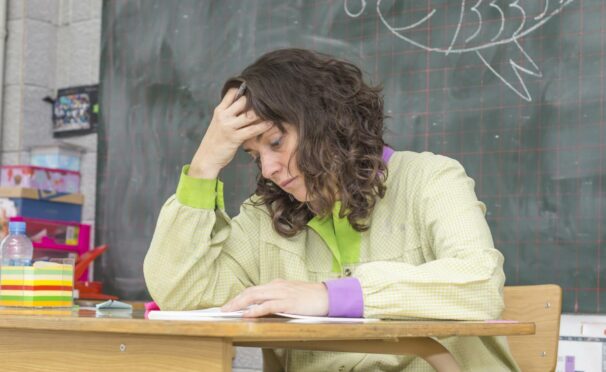Almost half of teachers did an extra day’s work each week during the pandemic, according to a survey that found soaring workloads.
School closures during lockdowns saw teachers switch to remote teaching and when they reopened they juggled class lessons with providing work for isolating pupils.
Cancellation of exams also placed a greater burden on secondary school teachers who had to conduct assessments and determine senior pupils’ grades.
According to the survey by the EIS teaching union, pressure has also been added by factors including pupil behaviour issues resulting from the pandemic, increasing additional support needs, staff shortages and Covid sanitising regimes.
“For the first time ever, I am seriously contemplating leaving teaching.”
EIS survey respondent
One teacher who described “overwhelming” physical and mental health strain said: “For the first time ever, I am seriously contemplating leaving teaching.”
The teacher workload survey completed by 16,000 EIS members found:
- 45% worked more than eight hours extra a week
- 88% saw workload increase during pandemic
- 80% of secondary teachers involved in assessing pupils for qualifications said this work was significantly greater than in a normal year.
Of those who reported an increased workload significant factors were:
- managing student behaviour in context of the pandemic (53%)
- meeting pupil additional support needs, including mental health-related (62%)
- inadequate staff levels, staff shortages, unfilled vacancies, etc. (59%)
Reporting to parents via phone calls, Twitter and teaching platforms such as Seesaw and Google Classrooms was described as “not manageable”, by one respondent to the survey conducted in November.
Another teacher said of online learning: “I spent a lot of time feeling I had to be visible online for the kids outside of ‘normal working hours’ to cater for those who couldn’t do school work when parents/carers were working.”
Coping with attachment behaviour among pupils and anxiety of parents who demanded more reassurance and communication, was highlighted by another respondent to the teacher workload survey.
Teachers are reporting a significant amount of time dealing with pupil behaviour as many young people struggle to overcome the negative impact of the pandemic.”
Larry Flanagan, EIS general secretary
EIS general secretary Larry Flanagan said: “Teachers have continued to face a rising tide of workload throughout the pandemic, for a wide range of reasons.
“Clearly, changes brought about in response to the pandemic have had an impact on teacher workload with additional tasks requiring to be undertaken on a daily basis to help keep classrooms safe.
“The increased emphasis on digital learning – be that in the classroom or remotely from home – has created challenges for teachers, often associated with a lack of suitable equipment and resources.
“Teachers are also reporting a significant amount of time dealing with pupil behaviour as many young people continue the struggle to overcome the negative impact of the pandemic on their lives.”
Teachers have been outstanding throughout the pandemic and we can’t thank them enough.”
Scottish Government
The Scottish Government pointed to increased teacher numbers and plans to reduce class contact time to allow teachers to deal with other tasks.
A spokesman said: “Teachers have been outstanding throughout the pandemic and we can’t thank them enough.
“We are committed to reducing teachers’ class contact time by 90 minutes per week to give them more time to plan and ease their workload.
“In the last year we have invested over £2 million in supporting teacher wellbeing with a package of support, developed in conjunction with the education recovery group.
“We have provided £240 million of additional investment since the start of the pandemic, specifically for the recruitment of more education staff.
“Figures published in December show that teacher numbers have increased for the sixth year in a row, rising to 54,285 in 2021.
“There are now over 2,000 more teachers than before the start of the pandemic in 2019, and more teachers than at any time since 2008.”









